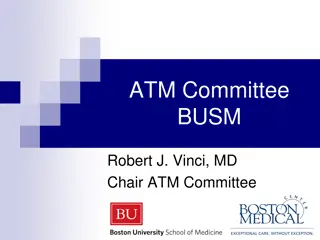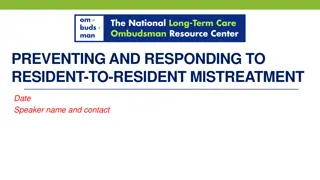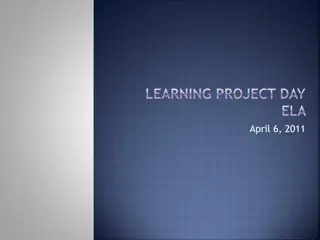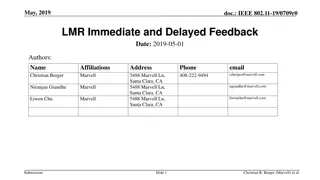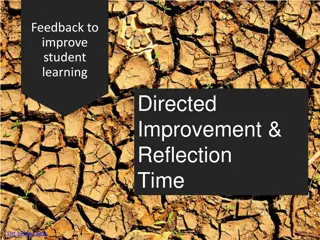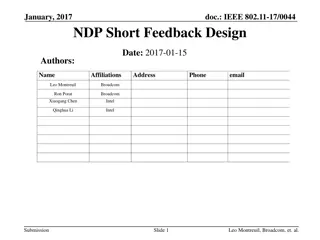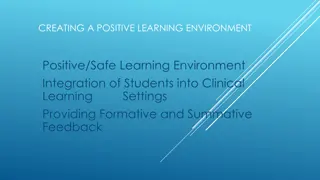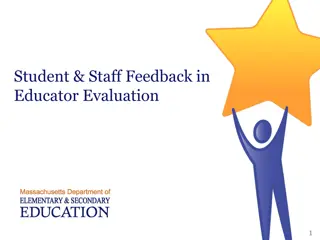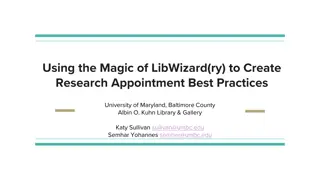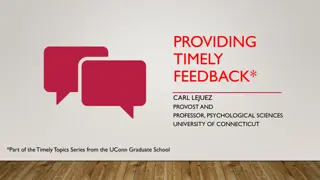Understanding Feedback and Mistreatment in Learning Environments
Explore the nuances between feedback and mistreatment in educational settings, reflecting on personal experiences and societal impacts. Examples of mistreatment and the importance of setting clear expectations for effective feedback are discussed, highlighting the detrimental effects of mistreatment on learners and educators.
Download Presentation

Please find below an Image/Link to download the presentation.
The content on the website is provided AS IS for your information and personal use only. It may not be sold, licensed, or shared on other websites without obtaining consent from the author. Download presentation by click this link. If you encounter any issues during the download, it is possible that the publisher has removed the file from their server.
E N D
Presentation Transcript
Reflection: Recall an experience when feedback given or received was taken out of context (try to think of each) Where were you? Did you give it or receive it? Who was involved? What was the outcome? What do you think caused it be seen as out of context?
Is it Feedback or Mistreatment? Establishing Expectations and Providing Feedback in Today s Learning Environment Lisa B. Israel M.Ed Director, Office of Professional Oversight
Disclosures None
Session Outcomes: Reflect on current societal issues that impact teaching and learning styles Recall personal experiences when feedback given or received was taken out of context View examples of varying forms of feedback Identify personal challenges in setting expectations and holding learner s accountable Understand basic tenets of effective feedback and mistreatment Consider takeaways from tips shared to apply to one s own learning environment
My Observations The OPO only hears the situations that fall on either side of the spectrum Meaning Too soft and over-generalized, often seen as disengaged Blame learners for not being adequate and provide abrasive feedback in front of others Much more happening based on word of mouth Failure to give feedback due to retaliation Just going to put down that everyone is doing well Cant evaluate honestly, because this crop isn t good They can t handle the truth
MistreatmentPoints to Consider Mistreatment Is hard to pinpoint; Is NOT the same as feedback (although often is sandwiched in); Has been associated with attrition, depression, and often times lack of self-efficacy; Can be direct or indirect (yelling/screaming, humiliation, denied opportunities, embarrassment, required to perform personal services, etc.); Does not occur in good faith; Adversely effects the learning environment; Impacts the relationship between learner/teacher;
Examples of Mistreatment Pimping Dismissive/Silent Treatment Humiliation Manipulation Fear-based Learning Yelling & threatening Continued and excessive questioning Rhetorical questions What s wrong with you, why don t you know this? Did you even go to Medical School?
What Mistreatment is NOT ? Actions taken in good faith by faculty/residents to correct unacceptable performance or inappropriate behavior (eliminating risk for patient harm) Pointing out in the learning environment (conferences, rounds, OR, etc.) that a learner is not prepared Taking away a privilege as a result of unpreparedness
FeedbackPoints to Consider Is different than mistreatment; In not always the good stuff; Verbal, non-verbal and written; Can range in its effectiveness; Includes both awareness of the positive and recognition of deficits; Should be formative and part of the learning process; Is a means to increase one s self-awareness, confidence, and skills; Provides opportunity to improve performance; Is most successful when the recipient understands the criteria for which they will be measured; Can be both written, oral, and reflective; Has best results when consistent in timing
Feedback Example #1 not the best but not mistreatment https://www.youtube.com/watch?v=DbfISZjG 9mU (9:00)
Stay Away from the Generic Learners report that much of the feedback they receive is generic and not helpful Learners talk in some cases people get the same generic response Examples to stay away from: Read more Well liked Knowledge on par for level of training Give examples Make a plan for improvement
Feedback Example #2 better but still lacking something https://www.youtube.com/watch?v=DbfISZjG 9mU (7:25)
Feedback for Millennials Today s learners have been getting feedback (often positive) throughout their lives Going to take the time to ask for it, but sometimes just want to know the positive Need to provide the good and the constructive Should be timely and formative Learner engaged
Feedback Example #3 now we are getting there https://www.youtube.com/watch?v=DbfISZjG 9mU (11:00)
Reflection: What do you see as the biggest challenges in setting expectations and holding learners accountable? What prevents you from providing feedback?
Why is Appropriate Feedback Avoided? Too busy Worried about hurt feelings Retaliation and poor counter evaluations Damage to relationship Worried about personal reputation
Tips for Giving Effective Feedback and Avoiding Mistreatment in the Learning Environment Expectations Set them early and have learners engage in the process Ask them what they want to learn responses must be articulated Be Specific Avoid generalizations because its quicker Provide unique feedback to individuals Make sure that it is something that actually could help a learner grow
Tips for Giving Effective Feedback and Avoiding Mistreatment in the Learning Environment Relevant Timely & Consistent Don t avoid it or wait too long Provide it when it matters Relevance to what is happening currently, not always after the fact Use the time together, effective feedback can happen in 60 seconds or less Plan a time or let the Learner know when you will go over things (stick to the plan, if possible) Frequency
Tips for Giving Effective Feedback and Avoiding Mistreatment in the Learning Environment Learner-engaged Have your learner feel comfortable asking for feedback. Encourage them to ask what is working? Challenge them to identify what they think is going well and what could be improved upon Verbal and Non-Verbal Communication Body language and facial expressions go a long way When giving feedback, try to use the learners name When constructive, use statements that start with when rather than if Neutral tone
Tips for Giving Effective Feedback and Avoiding Mistreatment in the Learning Environment Action Oriented For all feedback that is constructive, try to have a plan for improvement or suggestions If possible, provide specifics (come prepared tomorrow with an outline of care, etc) Let people know you are going to give them some feedback, I have some feedback Objective


